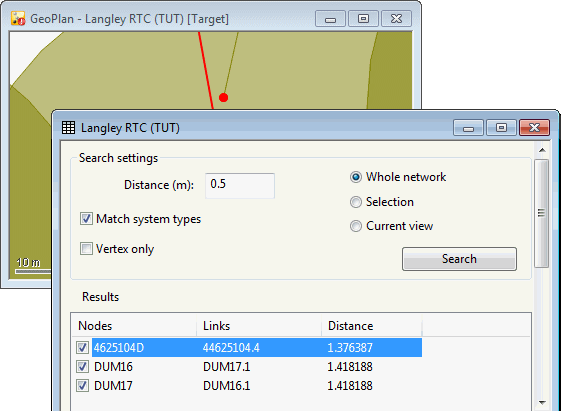The proximity trace tool searches for nodes that lie within a specified distance of a pipe to which the node is not connected. This may indicate connectivity problems and identify locations where nodes should be connected into adjacent pipes.
The tool gives the option to analyse each occurrence, before correcting the connectivity by snapping the node to the pipe or the pipe to the node.
The following screenshot shows a proximity trace example:

The tracing process
To carry out a proximity trace
- With a network open, select Tracing tools
 Proximity trace from the GeoPlan menu. This will display the
Proximity Trace View.
Proximity trace from the GeoPlan menu. This will display the
Proximity Trace View.
- Edit the search settings if required:
- Distance - the trace will look for nodes that fall within the specified search distance of a pipe to which the node is not already connected.
- Search area options - select the area of network to be searched.
- Match system types - check this option to only include nodes that lie within the search distance of a pipe of the same system type as the node.
- Vertex only - check this option to search for nodes that fall within the specified search distance of a pipe vertex only.
- Click the Search button to list nodes that lie within the search distance of another pipe and match the criteria selected above.
Processing detected nodes
Once the proximity search has been carried out, the results may be analysed before correcting connectivity.
Zooming in on a node
Select search results from the Results list of the Proximity Trace View by clicking on a row in the list. Hold down the SHIFT key to select multiple adjacent results or the CTRL key to select multiple non-adjacent results.
The GeoPlan Window will zoom in to the maximum extent possible showing all selected nodes and their adjacent pipes.
Correcting connectivity
To use the Proximity Trace View to snap nodes and links detected by the proximity search
- In the Results list, check the boxes of the detected nodes for which connectivity correction is to be carried out. Use the Select/Deselect all button to check/uncheck all of the items in the list.
- Select a snapping option: Snap link to node or Snap node to link.
- Select a Flag to be applied to recalculated link properties, such as Length and US/DS node ID.
- Click the Correct connectivity button to snap the selected node and adjacent links together according to the snapping option chosen.
- The
Move Node dialog will be displayed:
- The Split Flag to be applied to recalculated link properties, such as Length and US/DS node ID is set to the Flag chosen in the Proximity Trace View by default.
- Select whether to split existing pipes or add a lateral node.
- Use the buttons at the bottom of the dialog to select action to be taken for each node:
- OK - snaps current node to adjacent pipe. The Move Node dialog for the next selected node in the Proximity Trace list will be displayed.
- Cancel - current node is not snapped to pipe. The Move Node dialog for the next selected node in the Proximity Trace list will be displayed.
- To apply an action to all nodes in the Proximity Trace list, check the Apply to all items option and click OK or Cancel.
When using the Snap node to link option and splitting the existing pipe:
- The node is moved to the nearest point on the adjacent pipe, (or to the nearest vertex on the pipe if the Vertex only option has been selected).
- The adjacent pipe is divided at that nearest point, creating two pipes.The length of the new pipes is:
- Recalculated from the GeoPlan if the existing Length field has the #D flag set.
- Calculated by splitting the existing defined Length based on where the node is placed in the existing link if the #D flag is not set. The Length field will be flagged with the flag chosen in the Move Node dialog.
- The node is now attached to the ends of the existing pipe and the new pipe.
When using the Snap link to node option, the nearest point, (or nearest vertex if the Vertex only option is selected), on the adjacent pipe of each node selected in the Results list on the Proximity Trace View is snapped to the node. The lengths of the new pipes are calculated as above.
When adding a lateral node, the distance of the lateral node from the pipe upstream node is calculated by geometry.
